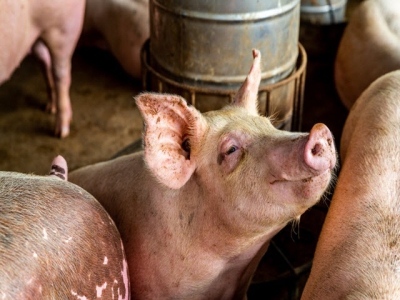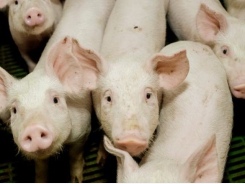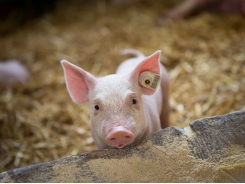Precision feeding may lower pig dietary protein needs, nitrogen excretion

Swine precision feeding systems may need new methionine to lysine ratios, however, the individualized system may allow for swine production with lower protein feeds while supporting gain, researchers say.
An international team of researchers from Canada and Brazil explored the use of two different feeding methods and varying levels of dietary methionine (Met) in the diets of growing swine.
“The objective of this study was to evaluate the effect of dietary Met supply on growth performance, carcass characteristics, and plasma biochemical variables in growing pigs conventionally fed with the same diet during the growing phase as proposed in CPF [conventional phase feeding] systems, or with individual daily tailored diets as proposed in IPF [individual precision feeding] systems,” the researchers said.
The researchers found that average daily gain, feed efficiency, final body weight, methionine and Cys intake and loin depth were lower for pigs in the IPF feeding system rather than on the CPF system.
But average daily feed intake and backfat thickness were similar, regardless of feeding systems, and both tended to increase as more Met was added to the diet.
For pigs in the IPF system, average daily gain grew linearly as more Met was added to the diet, they said.
The intake of lysine (Lys) was reduced for pigs in the IPF system compared to CPF but increased quadratically as more Met was added to the diet regardless of feeding system used.
Plasma urea nitrogen (N) was reduced and creatinine increased for pigs in the IPF systems compared to CPF pigs, but both increased with added Met levels, they said.
Alanine aminotransferase was also higher for pigs in the IPF system but was not altered by Met.
However, total plasma protein, C-reactive protein and triglycerides did not alter based on feeding system or dietary Met level, they added.
“The increase of Met:Lys in IPF allowed pigs to have the same ADG receiving 40% less CP and 27% less Lys, whereas receiving the same amount of Met than CPF pigs,” the researchers said. “The difference between the optimal dietary essential AA ratio for CPF and IPF systems is probably related to the fact that IPF pigs eat, in relation to CPF pigs, 27% less Lys and that this reduction cannot be applied to all other dietary essential AA.”
Using tailored or conventional feeding systems
In a conventional feeding system, pigs are raised in groups and have set feeds for a growing phase, the researchers said. But pigs within those groups may differ in body weight and growth potential, meaning they have different nutrient requirements.
“When feeding pig populations, nutrition requirements should rather be defined as the amount of nutrients needed for specified production purposes, which in farm animals consist in optimal production outputs (e.g., maximal growth rate),” they said. “Unfortunately, optimal population responses are obtained with nutrients inclusion rates that satisfy the requirements of the most demanding animals, resulting in most of the pigs of the population receiving more nutrients than they need to express their growth potential.”
Conventional farms can have low efficiency in terms of transforming dietary energy and nutrients into animal products, they said. Protein efficiency in production systems can range from 15% to 33%.
However, using precision feeding may be a way to improve upon a conventional group-feeding system (CPF) as it feeds pigs with a tailored meal using individual precision feeding (IPF) diets determined using daily feed intake (DFI) and body weight, they said.
“Recent research has demonstrated that relative to CPF systems, IPF can reduce Lys intake by 26%, nitrogen excretion by 30%, and feeding costs by 10%,” the researchers added.
Why alter methionine levels in swine diets?
In commercial pig diets, lysine (Lys) is considered a first limiting amino acid (AA), the researchers said. It is used to establish other AA requirements, which are expressed relative to Lys.
Methionine and Cys (sulfur AA) tend to be the second or third limiting AA, they said.
“Actual sulfur AA:Lys might not meet the requirements of actual pig genetic lines, which are characterized by a higher protein deposition rates than former genetic lines,” they added.
Feeding trial details
During the feeding trials, 60 pigs were raised using one of two feeding systems – IPF or CPF – and received a trial diet for 24 days, the researchers said. Feed remaining in feeders was removed and weighed daily.
Diets included three levels of Met inclusion at 70, 100 or 130% of the 0.30 Met:Lys level recommended, they said. Three diets – diet A, diet B and diet C – were used to tailor diets nutrient levels for pigs in the IPF (Diets A and B) or CPF (Diet C) systems and Met levels were added to those generated feeds.
Diets with high and low nutrient density (diets A and B) were developed to meet mineral and AA requirements with high diets tailored to the most demanding pigs and low nutrient diets being matched with less demanding pigs, the researchers said.
“Dietary treatments for the IPF pigs were obtained by blending the experimental diets (A and B) in the required proportions to obtain the desired Lys concentrations to meet individual daily requirements,” the researchers said. A third diet, diet C, was used with pigs in the CPF system and energy and Lys levels were estimated on the average pig.
Optimal dietary standardized ileal digestible (SID) for Lys level was established daily for pigs in the IPF system using a mathematical model considering daily feed intake, body weight and daily gain, they said. Adding, “The optimum daily concentration of SID Lys (g/kg) of the feed to be provided to each pig was calculated by dividing the estimated daily SID Lys requirement (g/d) by the expected starting day DFI (kg/d).”
“Each pig in the IPF treatments received daily a blend of feeds A and B having the calculated optimal Lys concentration while CPF pigs received the same C diet throughout the entire experimental period,” they said. “Methionine was provided according to the assigned treatment to each pig by using the corresponding 70, 100 or 130% inclusion rate in the diets.”
Feed intake was noted daily, body weight measured weekly and biochemical variables in plasma were recorded on days 1 and 24 of the feeding trial, they said. Pigs also were checked for backfat thickness and loin muscle depth at the start and end of the trial.
Blood samples were collected for enzymatic and protein analysis, they added.
Results
Pigs in the IPF system had lower final body weights, ADG, gain to feed ratios, Met intake, Cys intake and loin muscle depth at the end of the feeding trial than pigs on the CPF plan, the researchers said.
However, as more methionine was added to diets for pigs in the IPF system, average daily gain increased linearly, they said. Adding, “The reduced growth performance of IPF compared to CPF pigs demonstrate the stronger effect of Met restriction in the IPF than in the CPF system.”
“Average daily feed intake (ADFI) and backfat thickness were not affected by feeding system, yet ADFI tended and backfat thickness increased quadratically with increasing Met inclusion rates,” they said. “Lysine intake was lower for IPF than for CPF pigs and tended to increase quadratically with the Met inclusion rate increase.”
Pigs in the precision system had diets tailored to Lys needs and as the Met levels were established using an ideal Met:Lys ratio, total Met provided was at a lower inclusion rate than for pigs in the CPF system, they said.
If the model used correctly provided the Lys requirement any AA limitation would happen in the growing period.
“This explains the observed differences in ADG response between the studied feeding systems,” the researchers said. “Furthermore, increasing from 70 to 130% the Met inclusion rate in IPF system resulted in a linear increase in ADG which indicates that pigs may require higher Met inclusion rate in relation to Lys in IPF than CPF feeding systems.”
Variations among the systems decreased as more Met was added to diets, they said. However, crude protein intake was about 64% higher for pigs in the CPF system compared to IPF pigs.
The level of plasma urea N was reduced, while plasma creatinine was increased for pigs on the IPF system compared to those in the CPF program, they said. ALT was higher, while AST tended to be higher for IPF pigs and neither were changed by Met inclusion rate.
Total protein, triglycerides and C-reactive protein levels in plasma did not vary based on either feeding system or Met inclusion, they said.
“The results from this study seem to indicate that the optimal AA ratio may differ between conventional and precision feeding systems and therefore, the ideal protein concept will need to be revised for adoption in IPF,” the researchers said.
Source: Livestock Science
Authors: A. Remus, C. Pomar, D. Perondi, J.P. Gobi, W.C. da Silva, L.J.de Souza, L. Hauschild
Related news
Tools

Phối trộn thức ăn chăn nuôi

Pha dung dịch thủy canh

Định mức cho tôm ăn

Phối trộn phân bón NPK

Xác định tỷ lệ tôm sống

Chuyển đổi đơn vị phân bón

Xác định công suất sục khí

Chuyển đổi đơn vị tôm

Tính diện tích nhà kính

Tính thể tích ao









 Study: Fasting on the day…
Study: Fasting on the day…  Provimi creates age-based swine feeding…
Provimi creates age-based swine feeding…